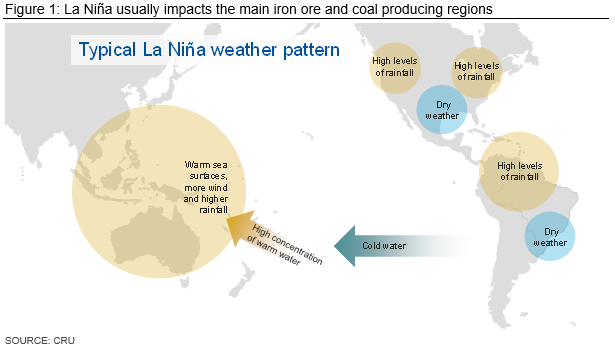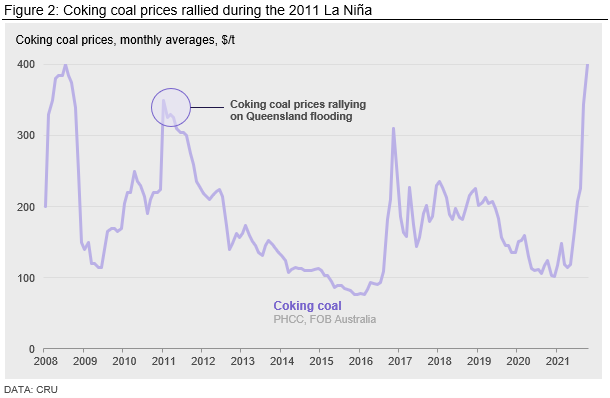Economy

CRU: Another La Niña Year – What It Means for Steel and Coal
Written by TiagoVespoli
November 22, 2021
By CRU Steel Analyst Tiago Vespoli, from CRU’s Steel Sheet Products Monitor, Nov. 17
There is a high probability that the weather phenomenon La Niña will start at end-November, which could have serious consequences for the steel supply chain, depending on the severity of the event. Some expected impacts include increased rainfall in Australia and northern Brazil, droughts in southeast Brazil and colder temperatures in China, Europe and northern parts of the USA.
![]()
What is ENSO?
During normal conditions, trade winds blow west along the equator, taking warm water from South America towards Asia. To replace that warm water, cold water rises from the depths, in a process called upwelling. El Niño and La Niña are climate patterns that break this normal condition, and they are opposite phases of the so-called El Niño-Southern Oscillation (ENSO). The system oscillates between neutral to warm (El Niño) or cold (La Niña) conditions on an average of 3 to 7 years and episodes of El Niño and La Niña typically last usually nine to 12 months.
There is an important indicator, the ENSO Outlook status, that sums up some criteria that need to be met to determine whether a La Niña or El Niño will occur or not. Any three of the following criteria need to be satisfied to confirm the event happening:
• Sea surface temperature (SST): A clear cooling trend observed in specific regions of the Pacific Ocean during the past three to six months.
• Winds: Trade winds stronger than average in the western or central equatorial Pacific Ocean during any two of the last three months.
• SOI: The two-month average SOI is +7 or higher.
• Models: A majority of surveyed climate models show sustained cooling to at least 0.8 °C below average in some regions of the Pacific Ocean by the late winter or spring.
Now, the ENSO Outlook remains at La Niña ALERT, but the chance of La Niña forming in the coming months is now higher than 80%. This is about three times the normal likelihood of an event forming in any year.

What is La Niña?
In a La Niña year, trade winds are even stronger than usual, pushing more warm water toward Asia. Off the west coast of the Americas, upwelling increases, bringing cold water to the surface in this area. This wind activity also culminates in a higher concentration of warm water in northern Australia and Southeast Asia and results in warm air rising and the formation of clouds. This typically leads to heavier rainfall and a higher chance of tropical cyclones in eastern Australia, a region that accounts for 52% of global metallurgical coal exports.
But the impacts are not only concentrated in these regions – several areas of the globe are affected by this phenomenon. It is worth mentioning the drought in the southeastern and central-western regions of Brazil while the northeastern and northern parts of Brazil are usually very wet. This generally means a positive favorable operating environment for iron ore producers in Minas Gerais, while production in the northern parts of the country will be negatively impacted. Other impacts of La Niña include colder winters in China and northeast Asia as well as drought and higher temperatures in the southern parts of the USA. In the northern parts of the country, we generally see wet and cold winters.
The last severe La Niña occurred in 2010–2012, which resulted in the heaviest rainfall at Port Hedland observed during the 2000s. In addition, we also saw heavy flooding across Queensland and Pakistan during this time.
The opposite phase is called El Niño, when the trade winds weaken (or reverse) and warmer surface water builds up in the central Pacific. So, this event is characterized by unusually warm ocean temperatures in the Equatorial Pacific, and an oscillation of the ocean-atmosphere system in the tropical Pacific. This can cause severe droughts in northeastern and northern Brazil, Australia and Indonesia, while parts of the Americas typically see higher rainfall. The strongest El Niño on record took place in 1997–1998 and the most recent one in 2015–2016, which raised global temperatures to record-high levels.

What a Strong La Niña Would Mean for Steel Production?
The outcomes of each La Niña can vary greatly. They depend on the intensity of the event, the time of year when it develops and the interaction with other climate patterns.
In Australia it can lead to higher-than-normal precipitation and more intense cyclones in Queensland, Australia’s largest coal-producing state. On the other side, in Western Australia, the effect is less significant, but it may also lead to above average rainfall, which could disrupt iron ore shipping activity somewhat. In 2011, during the last severe La Niña, Australia was hit particularly hard by floods impacting three-quarters of the state of Queensland and shutting down over half of the global seaborne coking coal market. Iron ore exports also dropped considerably during the first two months of that year, but this was mainly due to the formation of several tropical cyclones that had little to do with La Niña.

Another potential impact of La Niña is a higher-than-normal rainfall in northern Brazil where Vale has its largest iron ore mines. Looking at the 2010-2020 period, rainfall in Q1 has been 45% higher in La Niña years compared with non-La Niña years. As a result, there is a high chance that iron ore shipments from northern Brazil can be disrupted over the first half of 2022. Meanwhile, it is feared that La Niña will further delay the rainy season in the Southern Cone and make 2022 an even drier year, exacerbating the drought in reservoirs and, consequently, worsening the hydropower crisis in southeastern Brazil.
In Southeast Asia and the Far East, La Niña brings lower-than-normal temperatures during winter and higher rainfall in Southeast Asia. This colder winter can result in higher thermal coal demand as more energy is needed for heating. China’s thermal coal market is already extremely tight, and if demand increases while coal supply from other regions, including Australia, gets worse, we could be looking at high thermal coal prices throughout this winter. Japan and India can also be affected by La Niña this winter experiencing temperatures 2 to 3 degrees lower than average, which should translate into higher heating requirements in those regions.
The likelihood of La Niña developing this winter has increased, and CRU believes its impact on the commodity markets can be even more severe than last year. Please reach out to the author for any further questions on La Niña and its impact on the steel market.
Request more information about this topic.
Learn more about CRU’s services at www.crugroup.com
TiagoVespoli
Read more from TiagoVespoliLatest in Economy

Steel exports recovered in May but still historically low
US steel exports rose 10% from April to May but remained low compared to recent years. This came just one month after exports fell to the lowest level recorded in nearly five years.

AISI: Raw steel production ticks up near recent high
The volume of raw steel produced by US mills inched higher last week, according to the American Iron and Steel Institute (AISI). After steadily increasing in April and May, domestic mill output stabilized in early June and has remained historically strong since.

Steel groups welcome passage of budget bill
Steel trade groups praised the passage of the Big Beautiful Bill (BBB) in Congress on Thursday.

Industry groups praise Senate for passing tax and budget bill
The Steel Manufacturers Association and the American Iron and Steel Institute applauded the tax provisions included in the Senate's tax and budget reconciliation bill.

Chicago PMI dips 0.1 points in June
The Chicago Purchasing Managers Index (PMI) slipped 0.1 points to 40.4 points, in June.
